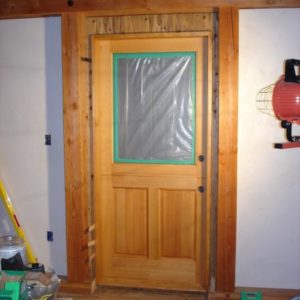Having trouble once again hanging an out-swing Dutch Door Set. Heavy Doug Fir w/glass upper sags on hinges and no backing behind hinge locations for 3″ screws (standard tactic on heavy in-swing doors). Considering changing the hinge gains (mortises) deepening the upper, shimming lower to remedy the sag, but last time I did this I still wasn’t satisfied. Ideas anybody? Thanks, Tom Sawyer, VSS
Discussion Forum
Discussion Forum
Up Next
Video Shorts
Featured Story

Tips for picking the right paintbrush based on paint type, surface, and personal comfort.
Featured Video
Builder’s Advocate: An Interview With ViewrailHighlights
"I have learned so much thanks to the searchable articles on the FHB website. I can confidently say that I expect to be a life-long subscriber." - M.K.
Fine Homebuilding Magazine
- Home Group
- Antique Trader
- Arts & Crafts Homes
- Bank Note Reporter
- Cabin Life
- Cuisine at Home
- Fine Gardening
- Fine Woodworking
- Green Building Advisor
- Garden Gate
- Horticulture
- Keep Craft Alive
- Log Home Living
- Military Trader/Vehicles
- Numismatic News
- Numismaster
- Old Cars Weekly
- Old House Journal
- Period Homes
- Popular Woodworking
- Script
- ShopNotes
- Sports Collectors Digest
- Threads
- Timber Home Living
- Traditional Building
- Woodsmith
- World Coin News
- Writer's Digest




















Replies
Why is there no solid backing behind the jamb at the hinge locations? And can you not make that happen because?
Fiddling with the hinge gain should be for fine tuning. Any "deep" mortising will come close to binding the hinge or cause edge of door to start to contacting the jamb.
The hinge gains are outside, in the plane of the siding, not the framing as with an in-swing door.
Submitted by VSS on Sat, 12/19/2009 - 17:24.
The hinge gains are outside, in the plane of the siding, not the framing as with an in-swing door.
Is there any way you can get something behind the exterior trim, that would act as a backer (instead of the siding-same plane as the siding, but firmly fastened to the jamb), that you could then fasten to framing.
Remove the top hinge and, in the hinge mortise, drive a couple of long GRKs in at an angle to cut into the jack stud.
Do you think with a bigger leaf you would be able to hit the framing?
A bigger hinge could put the screw holes closer to the stop. Bigger hinges aren't just taller, they are wider as well.
Does that make sense?
I'm guessing you need to
I'm guessing you need to secure the jam to the framing and let the jam carry the hinges. Pull the inside trim and secure the jame along its length. If need be, add strength behind the hinge with plywood and PL.
Thanks for your suggestions. I've already countersunk, counterbored, and 3" screwed the jambs to the framing, and have a strong feeling the sag is actually due to slop in the hinges, not deflection in the hinge side jamb. I'm thinking maybe some high quality hinges might make a difference. Mostly, I curse the new customer fad for out-swing doors.
I second what IdahoDon said about "adjusting" your hinges.
I fine tune doors all the time this way.
I usually don't take off the hinges.
I use a cresent wrench over the barrels of the hinge.
I do make sure I bend them all the same distance and in line with eacher. I put a straight edge against the side of the barrels to make sure they are the same and aren't twisted. The cresent wrench does put a small mark on the hinge but unless you are looking for it it isn't that bad.
I don't do this in front of other people if I can help it.
What they don't know won't hurt them and they get a working door.
Closing the hinge (bending next to the hinge pin) is a common requirement for such things for exactly the reason you are dealing with. Many times closing the hinge is a simple matter of clamping the bare hinge in a padded vice or with a few stiff clamps. To open it (more of a gap in the hung door) I use a 16d nail in near the pin and clamp the hinge in a clamp or two. I've never had luck bending hinges while on the door although guys talk about it all the time.
Good luck!
I've done the bending on a
I've done the bending on a hung door several times, just dropping a screwdriver or some such into the hinge near the knuckle, then pressing the door closed.
I wouldn't try it on heavy hinges, but it works OK on lightweight interior hinges (and I haven't destroyed a door yet, though sometimes they complain a bit).
Having run a door shop for 5 years and machined many fire rated and commercial doors. I have found that commercial grade ball bearing hinges rarely "sag". With a residential grade hinge anchored to the jack stud, you can experience sag. I always use a commercial BB hinge on doors that have glass in them. That would be my solution.
Seems like the door face and jamb should be flush w/ the exterior sheathing, not the siding. The screws for the hinge, then should be positioned in line w/ framing. Do agree w/ the comment that if you have no access to framing to screw the hinge to, that you provide solid support for the jamb at those locations so the weight of the door can be transferred through the jamb to the framing.